

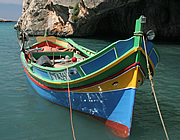
The ancient historical sites of Malta and Gozo deserve to be more widely known - very well-preserved and mysterious remnants of a long-gone civilisation.
We stayed in two wonderful hotels, had some great food - fantastic fish - and got completely lost on a day-long walk on Gozo!
And the spring flowers are beautiful.
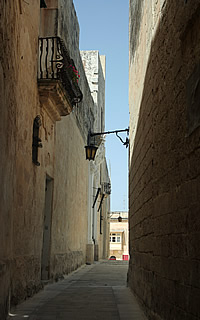
Malta has an illustrious history: from the prehistoric settlements with their magnificent temples to the siege of the Second World War the island has an eventful past. The Knights of St. John have a long association with the island. The Knights have their origins in the Christian Crusades of the eleventh and twelfth centuries, when a hospital and guest house was founded in Jerusalem by monks. It was granted independent religious status by the Pope and was known as the Hospitallers. More hospitals were set up on the pilgrimage route to Jerusalem from Italy, Knights offered their services for protection, keeping the roads free of bandits. After defeat in the Holy Land the Order settled in Cyprus then Rhodes, hoping to return to reconquer Jerusalem. In 1530 they were given Malta by Emperor Charles V.
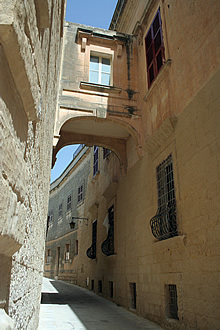
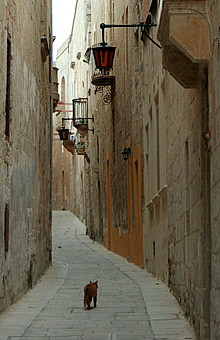
In Malta we stayed in the Xara Palace, in the medieval city of Mdina, the old capital.
Mdina was fortified around 1000BC by the Phoenicians - they called it Malet, meaning Place of Shelter. The large Roman town built here was called Melita, and Arab settlers in the 7th century gave it its present name - the medina being a walled city. The suburbs - Rabat in Arabic - were separated from Mdina by a deep moat, also created by the Arabs.
Later Mdina was known as Citta Nobile - Noble City - and became the favourite location for the aristocracy. It began to fall in significance when the Knights of St. John chose Valletta as their base, because of its Grand Harbour.
Napoleon occupied Malta in 1798. He stayed only six days but left with riches looted from the Order of St. John (these were mostly lost when Nelson destroyed the French Fleet at the Battle of the Nile). His force of 4000 left on the island attempted to subjugate the population which then rebelled, massacring the French garrison at Mdina, and appealing to the British for help. A naval blockade eventually forced the French to surrender in 1800.
There are things to see in Mdina - the cathedral of St Paul for instance - but it's the beautiful city itself and the fine views which make this such an appealing place.
We found that there were not many tourists when we visited, perhaps it was outside the main tourist season, so Mdina was very peaceful and the narrow streets flanked by tall honey-coloured stone buildings a beautiful place to stroll around.
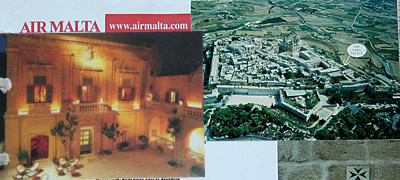
The Xara Palace Hotel is a 17th century palace, originally belonging to the noble Moscati Parisi family. It was used by the British in the Second World War and converted into a hotel in 1949. In 1996 it was bought and renovated by the Zammit Tabona family to its architectural origins. Some of the guest rooms were taken back to their original height of over six metres, allowing for the inclusion of a mezzanine floor, and ours was one of these. The huge four metre high window on the stairs to the mezzanine level looked out onto the piazza in front of the hotel.
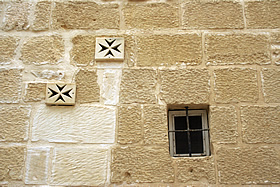
The hotel is built into the city wall and the dining room is right on the edge so breakfast here by the window with a wide view over the island to the sea - Mdina is perched on a hill top - is a lovely way to start the day - especially with warm chocolate croissants! We discovered when we checked out that we had been charged the equivalent of £15 each for breakfast each morning - rather a rip-off, even if the croissants are warm. We also had a very poor meal in the trattoria attached to the hotel which was a bit disappointing.
On our first day our car was delivered by the rental company and we set off on our explorations.
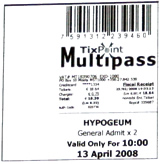
The Hypogeum was top of our list of "must sees" and we had pre-booked tickets. It is advisable to book in advance for a particular date and time as they are usually sold out well beforehand. Only a limited number of visitors are allowed in each day. Photography is forbidden.
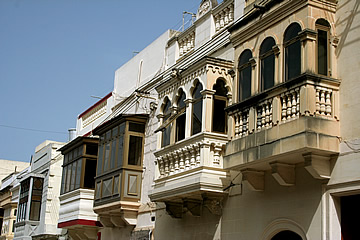
The Hypogeum lies behind - and below - a very unassuming entrance on a narrow street in Paola. An underground necropolis, dug by hand out of the limestone into a series of passages and chambers, it is thought to date from 3600 to 3000 BC and contained possibly 7000 bodies. The guided tour is in groups of 10, first with an audio guide and a small museum-type exhibition, including a copy of the Sleeping Lady figure (the original is in the archaeology museum in Valletta), followed by a 12 minute film. Then on to the tombs which are very atmospheric and impressive, laid out on three levels.
The first level is thought to have been extended from natural caves and is the oldest level. The second level below has several amazing spaces and these are not just hacked-out caves - they show architectural awareness in features such as trilithons which are doorways formed by two vertical stones topped by a horizontal stone, and stepped features in cornices reminiscent of beams.Some of the walls are painted red ochre. The Oracle Chamber has a hole in its wall and through it low-pitched voices become amplified and reverberate. Most impressive of all is the Holy of Holies which is illuminated at sunrise of the winter solstice through a shaft in the rock.
Apparently each burial chamber was first dug from the rock below the level of a doorway. Bodies were first decayed in the open air and then thrown in until the level of the door was reached, then one of the chamber walls would be broken through and the process repeated.
The tour was excellent, though the lighting on each point of interest comes and goes as the tour proceeds, and it's not for the claustrophobic!
An unbelievably atmospheric visit.
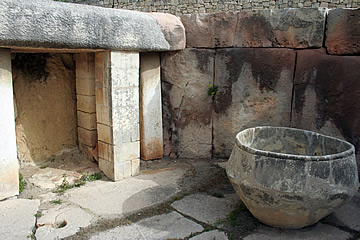
Most of the Megalithic Temples on Malta date from between 3600 and 3000 BC. They are the oldest free-standing stone structures in the world - 500 years older than the great pyramids of Egypt. They all share much the same structure and orientation, roughly facing south east with a cloverleaf plan, each "leaf" having three or five rounded chambers opening off its axis. Common features are holes in the stones which may have been made to hold posts, so-called "oracle" holes perhaps used by priests or priestesses to issue divinations - the arrangement of the hole within a chamber serving to amplify the voice, "fat lady" figurines or statues. No burials are associated with the sites. None of the original wooden roofs remain. It is possible that most Maltese temples were built such that the sunrise at Winter Solstice shone through the entrance.
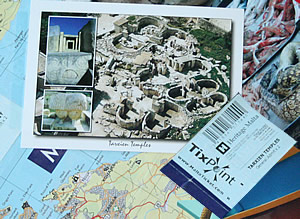
In the Valletta suburb of Paola, not far east of the Hypogeum, the Tarxien Temples date from between 3600 and 2500BC on a site of about 200sq m. As a point of reference, the wonderful Megalithic stone circles at Stonehenge in England, covering an area of about 1600 sq m, date from around 2200BC.
The Tarxien Temples are not as imposing as Stonehenge, and do not have the very complex astronomical design that characterises the layout of Stonehenge. Though a small site it is still impressive and the four linked temples are nevertheless quite intricate.
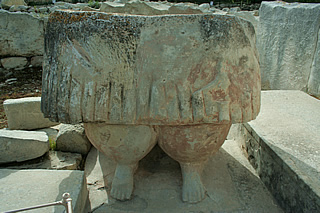
They were built with huge blocks of stone 3m x 1m x 1m in size. The chambers are decorated with spirals - a favourite device it seems - and animal reliefs. The rounded shape of the chambers is difficult to make out on the ground - much better in an aerial view which can be seen in postcards.
Spherical stones left at the site point to the method of construction: the blocks were probably rolled on these, pulled by oxen or some other beast of burden.
The temples have four, five or six apses and would have witnessed scenes of ritual animal sacrifice. In the Bronze Age, around 2000BC, it seems to have been reused as a cremation site. It was discovered by farmers in 1914 and then excavated.
The originals of the most interesting artefacts, in particular the lower half of a wonderful "fat lady" - a fertility goddess - are now in the museum in Valletta.
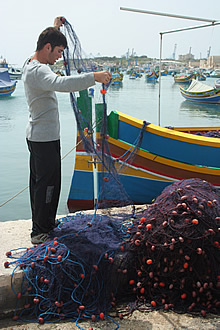
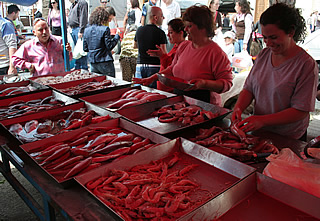
On the south east coast of the island, at the head of a bay, this ancient fishing village is quite a contrast to the even more ancient remains elsewhere on the island. Here the brightly coloured traditional fishing boats can be seen alongside the occupations and attributes of a fishing village: fishermen gathering and mending their nets, a large market spread out the length of the waterfront with the fish stalls at the eastern end, and wonderful fresh fish to eat.
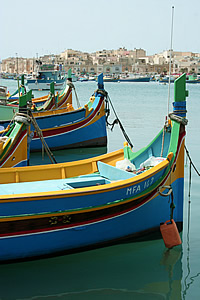
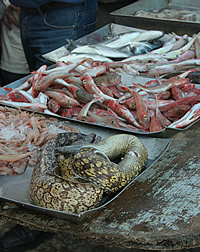
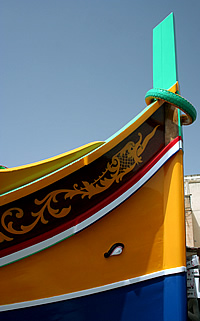
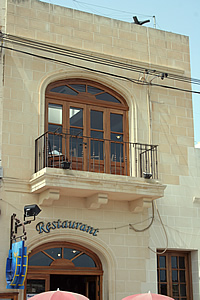
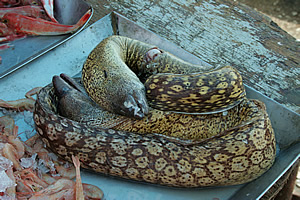
We had one of our most memorable meals here - not just on Malta but anywhere we have been. At Ron's Place we very nearly didn't stay as we were first shown to a very small table at the back of the first floor restaurant - the only table free - but we were persuaded by Ron "the fish is very good - if you don't like, don't pay".
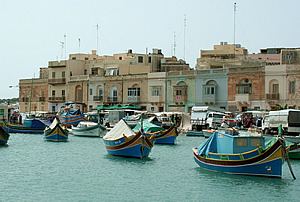
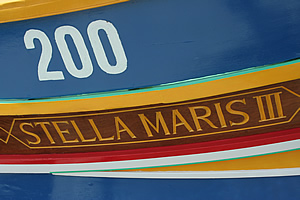
We had a beer downstairs while the best table in the house became free (Spielberg's table!) in front of the glass doors leading onto the balcony overlooking the harbour.
As we went up the stairs a customer coming down said she was so glad we'd changed our minds - we wouldn't regret it.
We didn't! We chose sea bream and bass, and they were absolutely superb. Accompanied by a chilled house white, we were in heaven.
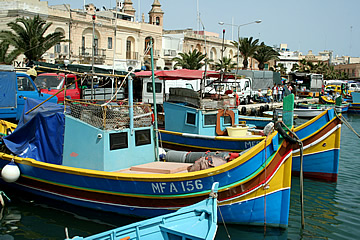
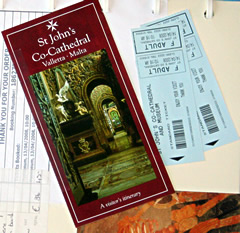
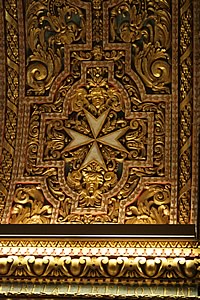
We were very lucky when we visited Valletta to park right at the top of the hill on the edge of this very compact city. This elegant city was built by the Knights of St. John in the sixteenth and seventeenth centuries to protect Malta from the Turks. Valletta is positioned at the end of a peninsula jutting north east into the Mediterranean and was thus a well-chosen location for their purpose. Although built for the purposes of defense, the city was made to be architecturally beautiful and remains so today, and full of history - the reason for it being made a UNESCO World Heritage site .
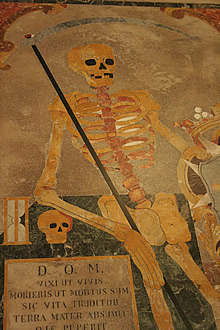
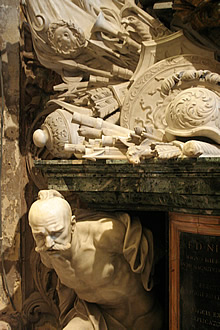
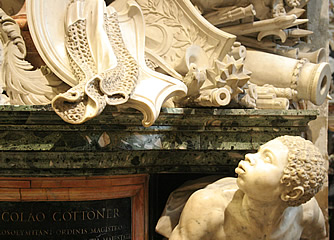
It was raining when we arrived so we headed straight for the cathedral - strictly speaking the St. John's Co-Cathedral. The term comes from it being granted equal status to St Paul's in Mdina by a papal decree in 1816. It was built in the sixteenth century as the church of the Knights of St. John, the rather plain exterior hiding a magnificent interior of baroque decoration. There are eight chapels representing the eight Langues or divisions of the Order. Rather too ornate for me but there are many details which I loved. The floor of the nave and chapels is covered with colourful marble tombstones depicting the coats of arms of the Knights buried there, many featuring skeletons. Some of the sculpture on the monuments is breath-taking, in particular the Tomb of Grand Master Nicola Cotoner in the Chapel of Aragon.
The English Chapel was not accessible at the time.
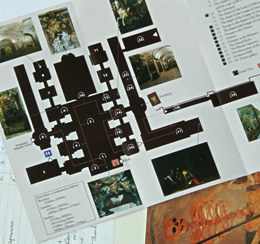
Most marvelous of all, two Caravaggios - the magnificent "Beheading of St. John the Baptist" and "St. Jerome Writing". Caravaggio had fled Rome where he was wanted for murder and arrived in Malta in 1607. He was admitted to the Order of St. John but was later imprisoned in Fort St. Angelo from which he escaped and fled back to Italy. The Beheading is a fantastic painting, the only one signed by Caravaggio, and displayed in the Oratory for which it was painted. The Baptist is sprawled on the ground while a prisoner watches through a grilled window, Salome waiting with a dish for her prize. The St Jerome is a more contemplative piece. They contrast very well: brutality versus peace.
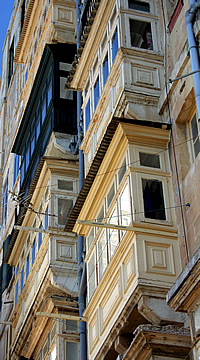
Outside the sun had returned once more and we wandered around the streets - every window seems to have a glassed-in balcony!
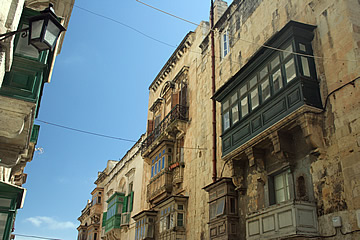
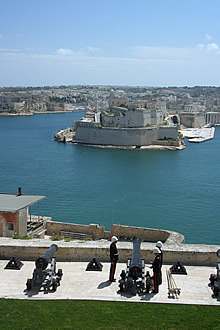
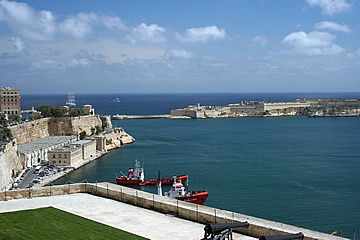
We paid a visit to the Archaeology Museum as so many of the temple artefacts are here. It's small but beautifully laid out, worth it for the "Fat Ladies" alone but also has some lovely decorative stonework from the temples.
We managed to time our arrival overlooking Fort St. Elmo and the Grand Harbour in time for the mid-day gun.
We had wanted to eat at La Sicilia which had a great write-up in the Lonely Planet Guide, but it was closed. So we ended up at Papannis where we had an excellent lunch: rabbit for me - a local specialty which I was really looking forward to trying and I wasn't disappointed - and ravioli for Andrew.
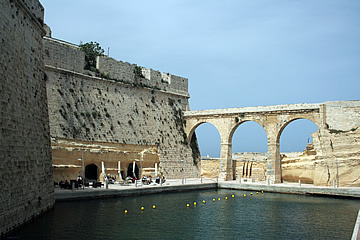
Vittoriosa lies on a spit of land south from Valletta across the Grand Harbour. Originally the very old town of Birgu it was called Vittoriosa - Victorious City - after the Knights of Malta successfully defended the city from an attack by the Ottoman Empire in the sixteenth century.
We wandered around admiring the boats in the harbour, making our way slowly up to Fort St. Angelo on the tip, rebuilt and strengthened in the sixteenth century by the Knights of St. John. The British took over in the nineteenth century and the Mediterranean Fleet was based here from 1912 to 1979. Today the upper part is once again occupied by the Order of St. John but most of the fort was closed at the time we were there.


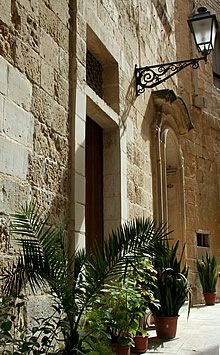
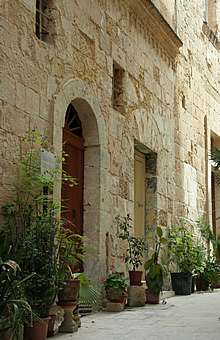
The Collachio area of Vittoriosa was developed by the Knights of St John in the sixteenth century, The quiet sandy-stone streets with their many-balconied houses and masses of plants in pots include a nice example of much earlier Siculo-Norman architecture, a style which derives from Islamic influence in medieval Sicily.
Eventually we stumbled on the "Malta at War" museum. It was only 20 minutes before closing and the attendant was reluctant to charge us anything so we made a 10Eu donation.

This is a Second World War era museum telling the story of how the citizens of Malta sheltered from the bombardment their island received from the Germans. The underground shelter, beneath the little square with its police station and government offices, was begun in 1940, with the aim of maintaining services during the war. The administrative area was backed by an accommodation area for the officials and their families. As the war progressed, however, more spaces were excavated to take care of local people during the bombings, until a vast labyrinth of chambers and passages had been constructed.
There is a small museum of artefacts but the really interesting bit is the underground complex of tunnels and rooms. We were the only ones down there and it felt like it would be very easy to get lost: long corridors, tiny alcoves for rooms, a birthing room, offices. All the spaces were very narrow and it must have been terrible to shelter here for hours or days from the bombs.
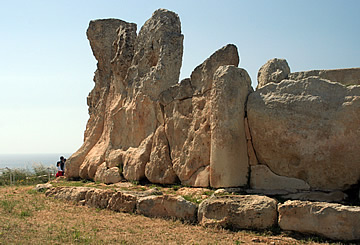
On the south coast the Megalithic temples of Ħaġar Qim and Mnajdra face the sea on high ground. Ħaġar Qim in particular has a magnificent setting a little higher than Mnajdra. Mnajdra was closed at the time of our visit, though we wandered down through the fields to see where it was.
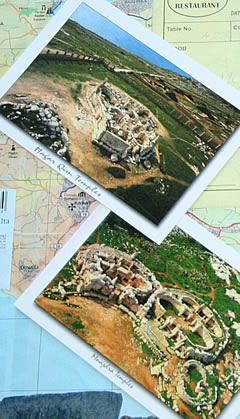
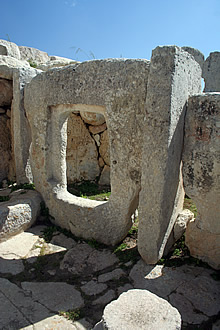
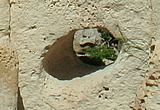
Ħaġar Qim has a restored trilithon entrance set in a long facade - this seems to be quite an unusual feature. At one end of this wall is a huge megalith, weighing over twenty tonnes.
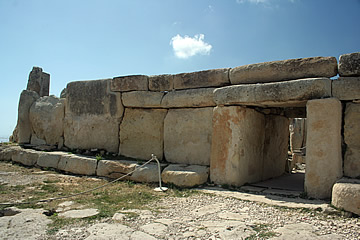
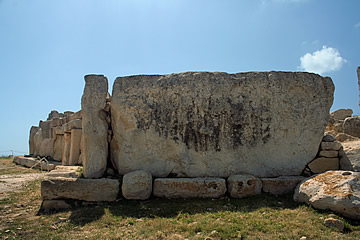
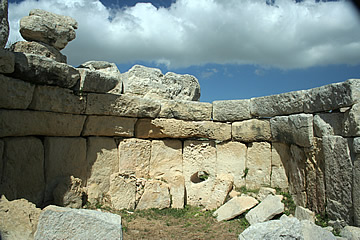
Ħaġar Qim is also unusual in that it does not have the normal trefoil shape but consists of a random series of interconnected oval chambers. However, "fat lady" figurines were also found here - now in the archaeological museum in Valletta.
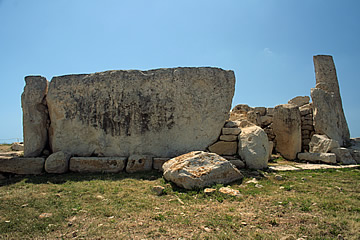
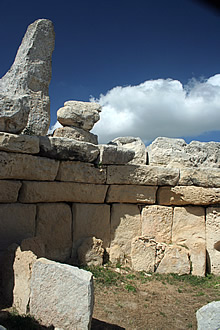
It seems to me that a five apse temple mimics the shape of a "Fat Lady"!

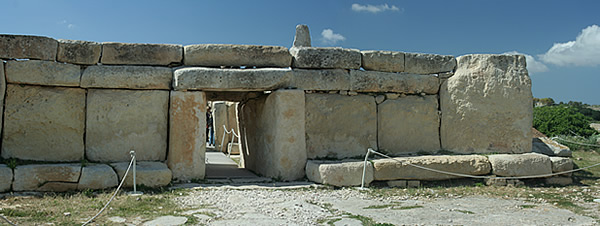
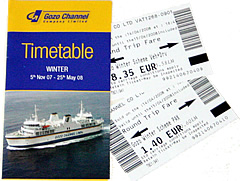
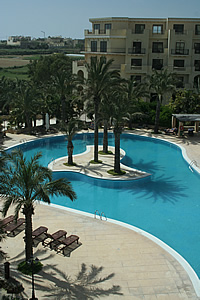
We took the ferry to Gozo, after a hair-raising drive cross country with poor maps when we found that the direct road to St. Paul's had been closed because of an accident. It's a nice ferry trip, passing the small island of Comino sufficiently close to get a glimpse of the Blue Lagoon - very blue indeed!
On Gozo we stayed at the Kempinski San Lawrenz. A little disappointed that our room faced the entrance side of the hotel we double upgraded to a room on the top floor in the new wing which overlooked the pool - very indulgent! We had a pizza in the bistro here the first night which was good but the wines were extortionately priced. Made up for by the excellent breakfast!
We actually did spend some time relaxing by the hotel pool which is most unusual for us. Joined each time by a friendly cat which was very adept at finding the most comfortable spot - usually on the lounger of a female guest!
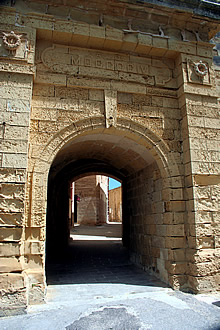
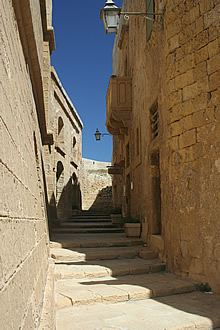
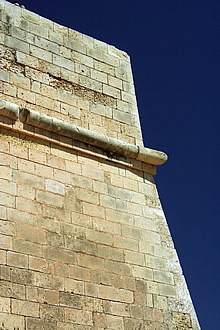
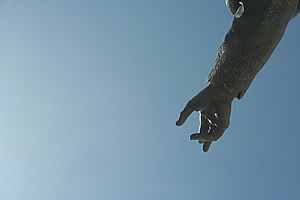
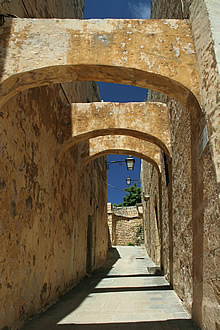
Gozo's main town is small and easily explored at a leisurely pace. Originally the Arabic-named Rabat it was renamed in honour of Queen Victoria.
The citadel, Il-Kastell, is perched above the town on top of the hill on which Victoria is also situated. It is this elevated aspect which has made the location a favoured site since Neolithic times, and its first fortifications were raised in around 1500 BC, the Bronze Age. Gozo was settled before Malta, settlers coming from Sicily. The oldest archaeological remains here date from around 5000BC. Later Gozo was occupied by Phoenicians, Carthaginians and the Romans and the citadel was continually developed during all these civilisations. In the Roman era it was quite independent from Malta and the citadel was the central point for administration, military and religious purposes.
We wandered around the maze of tiny streets in the old town a bit, around Piazza Indipendenza - the piazza was occupied by a market each day we visited - but the main attraction is the citadel.
Of the citadel to be seen today, the north side dates from the late thirteenth century when under Aragonese rule. The south side was re-constructed under the Knights of St. John between 1599 and 1603 when the island was in desperate need of protection from Turks and Berbers. Until 1637 everyone on the island was obliged by law to spend the night within the citadel for their own safety.
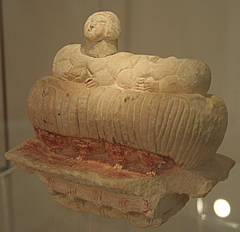
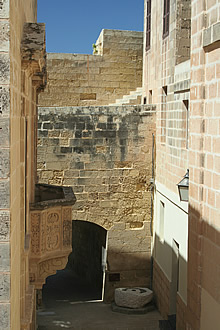
In 1551 Turks turned their attention to the island after failing to take Malta and succeeded in forcing the island to surrender after bombarding the citadel. Almost the whole of the population were taken into slavery.
Today the citadel is an intriguing place to wander around. We were practically the only visitors there during our visit and enjoyed trying to identify the various ruins which lie past the baroque cathedral (which stands on the site of the Roman Temple of Juno). Pretty good ramparts too, with fabulous views across the island.
There are several museums within the citadel and the little archaeological museum is well-worth a visit. It has some lovely artefacts: a wonderful twin "Fat Ladies", some beautiful slim figurine votives and an extraordinary stone slab with a snake carving which was found at Ġgantija Temples.
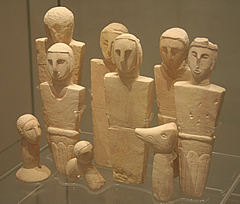
We had an excellent lunch at Ta' Rikardu in the citadel. One plate of local specialties: cheese, bread, tomatoes, capers, olives - which I had most of, one plate of large ravioli which Andrew had most of, and the home-brewed wine - very enjoyable.
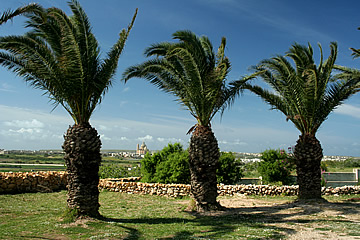
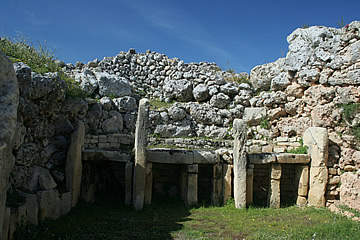
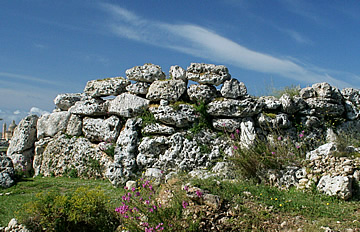

These are the largest of any of the megalithic temples found on the Maltese islands, and were built between 3600 and 3000BC, so this makes them one of the oldest too - only Ta'Hagrat and Skorba on Malta are older and these are composed now of only a few stones.
Here at Ġgantija the two temples are in a very good state, some of the walls still standing to a height of 7m.
Each temple follows the typical plan of a trilithon entrance and central corridor flanked by two sets of semi-circular apses and a fifth apse or altar niche at the apex. Again, as usual, they are set in a fine location commanding extensive views across the island.
The south temple is the oldest, part of its wall was removed to allow the north temple to be built against it.
The internal walls of these 5000 year-old structures were plastered, the wooden roof probably supported on timber beams.
I wonder what ancient ceremonies were performed here.
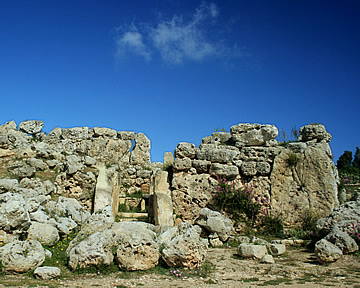
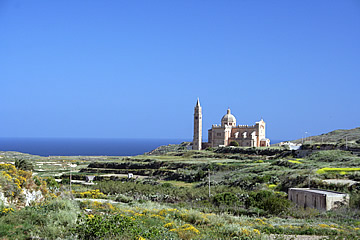
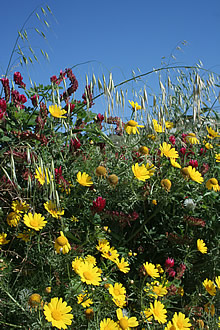
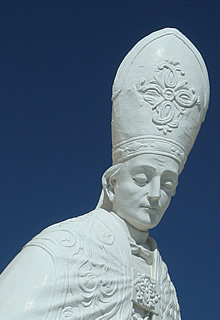
We had great difficulty finding good maps for Gozo - in fact we didn't find any! We wanted to walk from San Lawrenz to Xlendi for lunch, via prehistoric remains on a hill not far from the hotel, then on to Dwejra on a coastal path - a route which sounds easy according to our guide book but, in fact, is impossible.
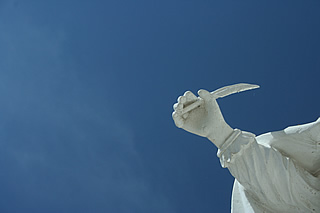
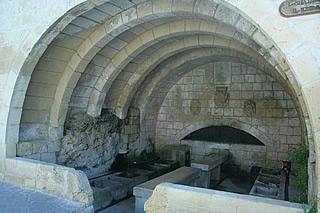
We began OK, lovely views across he island and gorgeous spring flowers, but after two abortive attempts up side tracks to find the prehistoric remains we gave up and just continued in the general direction of Santa Lucija. We decided not to risk going to Santa Lucija and scrambling down the cliffs to Xlendi but hedge our bets and take the rather better-marked route of skirting Victoria then south - all roads, unfortunately, but at least we'd know where we were!
We passed through Saint Augustine Square on the south side of Victoria. It has some dazzling white statues in front of the monastery.
There was an interesting wash house in the village of Fontana, now a southern suburb of Victoria, created over a natural spring (hence the name of the village) in the sixteenth century and provided with stone basins and benches.
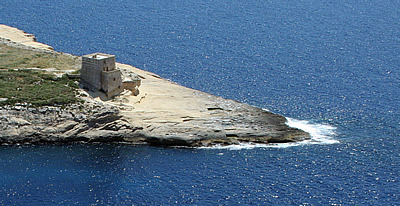
It got hotter and hotter and we arrived in Xlendi at around 11:30 to enjoy a cool, leisurely beer at Ic-Cima high on the southern cliff top overlooking the fishing village and its attractive bay. On the southern point is the 17th century watch tower Torri ta'Xendi.
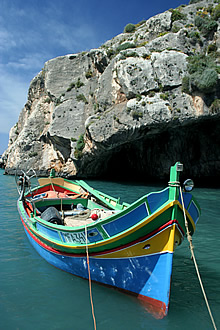
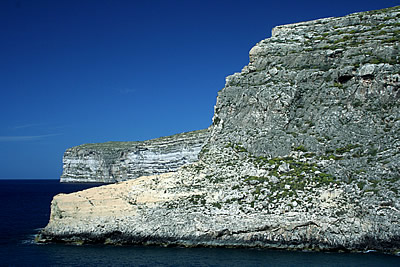
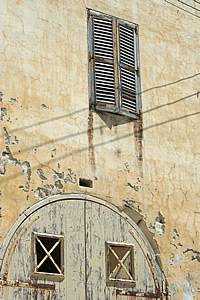
We had lunch at The Stone Crab, at the head of the bay, taking a table right on the edge overlooking the water - a slight mistake as the sun was deceptively strong, though there was shade and a cooling breeze. We had very good crab penne, though in truth I couldn't taste much crab.
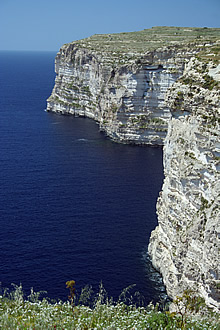
After lunch we scrambled up the cliff face - we'd been watching other people do it so could see the general route - to start the walk to Dwejra. The coast here has the most wonderful cliffs, dropping steeply into the deep blue sea.
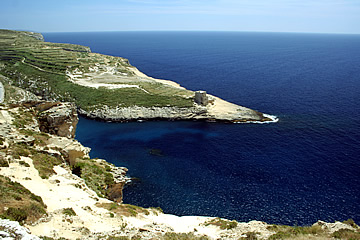
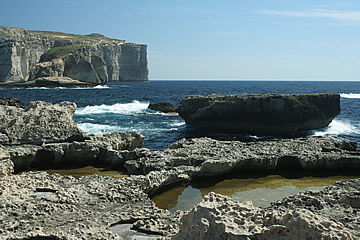
The path was very difficult to find in the rocks, though we did see one cairn. Eventually, as we could not find a coastal path, we worked a little way inland and asked a local who said "keep turning right" - completely useless advice - we almost immediately started down the wrong path! We decided to take a reasonable-looking road with lorries going up and down, which appeared to be heading in the right general direction. We came to a large pool with families sitting in the shade and were advised to just keep going - fortunately we had water with us as the heat was unrelenting. It turned out that the lorries were going to and from a small quarry which we passed, leaving the road at this point to join a track. We nearly lost the way again, but then spotted the famous Fungus Rock and a family walking towards us from the direction of Dwejra, so knew we were OK!
Fungus Rock takes its name from a plant found here - the only place in Europe that it grows - which has no green leaves, is dark brown and club-shaped. The Knights of St. John used it for its powerful medicinal properties. A General of the Order discovered it (the other name for the rock is the General's Rock) and Qawra Tower was built to protect the valuable resource.
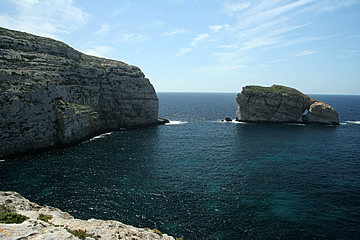
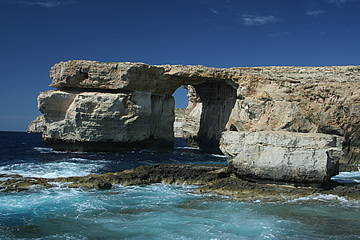
Over the cliff top to Dwejra Point and the Azure Window which is very picturesque - a huge natural rock arch jutting out from the coast. The strong sun had evaporated sea water from the rocks and left heavy salt deposits. There were many locals here enjoying the scene - it seems to be a popular spot.
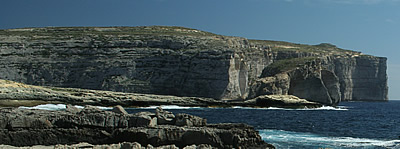
The final climb up to San Lawrenz was tiring and we were very happy to get back to the welcoming comfort of the Kempinski.
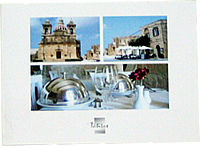
That evening we ate at Tatita's, situated on the picturesque San Lawrenz town square. We both had fish soup to start then I had king prawns and Andrew a rather odd stuffed quail, but on the whole very nice. We had a bottle of the local white Isis (as recommended by Ron of Ron's Place in Marsaxlokk).
We slept exceedingly well that night.
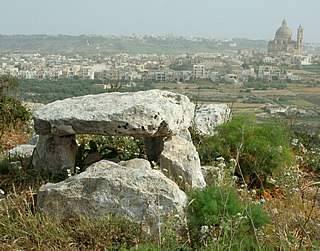
Guide Books and tourist info make much of the prehistoric "cart ruts" on the island, some of which can be found on the Ta' Cenc plateau.
One evening, before an excellent meal at Jeffrey's in Gharb (I had superb rabbit and Andrew excellent beef pancakes) we scouted out the location before returning the following day to explore. Thanks once again to the dearth of useful large-scale maps and instructions we had a hard time of it. We spotted the prehistoric dolmen off to the left of the track, in fact there seemed to be several of these. They are formed by three upright stones supporting a flat stone. Usually they formed a part of a barrow and were covered with earth and stones.
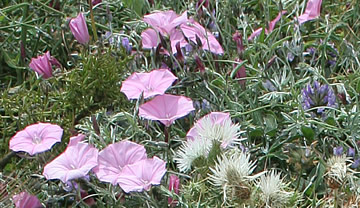
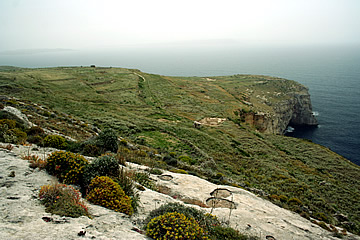
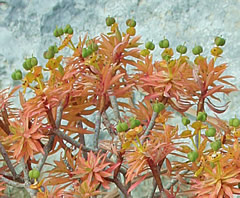
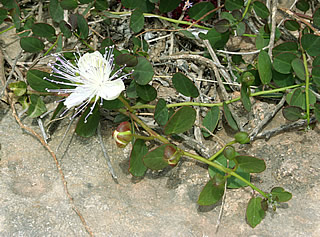
We roamed far and wide across the plateau and were singularly unsuccessful in finding any "cart ruts". But there were some fine views with Comino and Malta visible in the distance, and the flowers were lovely.
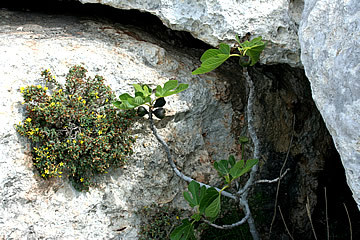
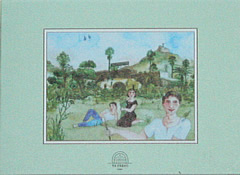
On our final evening on Gozo we ate at this wonderful restaurant which is in a lovely converted farmhouse in the north of the island. We had some very good meals on the island but this was the best.
First the local champagne while choosing our food and it was very good. We both had cheese soufflé to start then I had a really superb house specialty of lobster pasta made at the table - I can safely say this is the best pasta dish I've had in any restaurant. Andrew enjoyed a very good rabbit with mushy peas. Crêpe Suzette for Andrew and a chocolate pudding for me finished a really excellent meal - a great way to end our holiday.